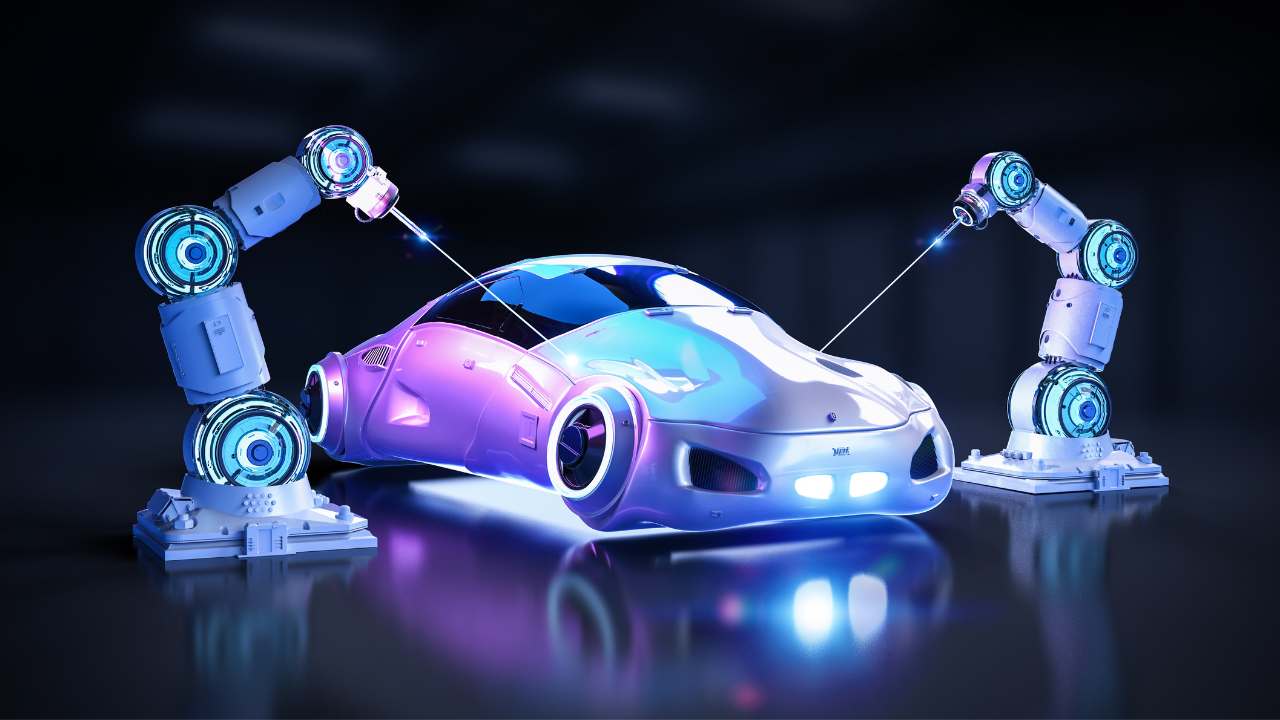The Industrial Internet of Things (IIoT) is a technological wave that’s reshaping industries across the globe. IIoT is driving unprecedented efficiency, productivity, and innovation in manufacturing and supply chain operations by integrating sensors, software, and connectivity into industrial equipment and processes.
The Industrial Internet of Things (IIoT) is changing how we make things and move goods. It uses smart technology to make things work better and faster. This means we can predict problems before they happen, make our supply chains faster, and move towards a new era in manufacturing.
At its core, the IIoT involves connecting machines, devices, and sensors within industrial environments to the Internet. This interconnectedness enables the collection and exchange of vast amounts of data, which can then be analyzed to gain insights, optimize processes, and make informed decisions in real time.
Key Takeaways
- IIoT changes manufacturing and supply chains by using smart tech and real-time data.
- It makes things work better by improving manufacturing, predicting maintenance, and managing assets.
- Supply chains get better at seeing and moving fast, helping us respond to market needs.
- Keeping the connected factories safe is very important.
- We’re moving towards Industry 4.0 with smart manufacturing and IIoT solutions.
Embracing the Industrial Internet of Things (IIoT) Revolution
The industrial IoT (IIOT) revolution is changing how we run our factories and supply chains. It uses intelligent connectivity through sensors and automation. This gives us real-time data insights that boost efficiency, visibility, and agility.
Integrating Intelligent Connectivity
The IIoT starts with connecting devices and smart manufacturing tech. Connected factories with sensors and industrial automation systems collect data quickly. This lets us make smart choices and improve our industrial automation work.
Harnessing Real-Time Data Insights
By using real-time data analytics, we can see and control more than ever before. Smart factories and remote monitoring let us fix problems early and boost operational efficiency.
| Key Benefits of IIoT | Impact on Manufacturing and Supply Chain |
|---|---|
|
|
“The IIoT revolution is reshaping the manufacturing landscape, empowering us to achieve new levels of efficiency, visibility, and agility.”
Driving Operational Efficiency with Smart Manufacturing
In today’s fast-paced manufacturing world, the Industrial Internet of Things (IIoT) is changing the game. It lets us automate processes and connect machines for better performance. This leads to higher productivity and efficiency in manufacturing.
Smart manufacturing uses IIoT to make our operations better. It automates tasks and helps us grow. With industrial automation, workers can focus on important tasks. This makes our operations more efficient.
Also, connected machinery gives us real-time data. This helps us make smart decisions and solve problems fast.
“The future of manufacturing lies in the seamless integration of smart technologies and connected systems. By embracing the IIoT revolution, we can unlock unprecedented levels of operational efficiency and position our business for long-term success.”
IIoT helps us make our manufacturing smoother and use resources better. It also boosts the effectiveness of our equipment. This approach to smart manufacturing helps us find and fix problems. It cuts downtime and keeps improving our work.
As we move into the digital age, using smart manufacturing is key to doing better and staying ahead. It’s a big step towards being the best in the market.
Predictive Maintenance: Proactive Asset Management
The Industrial Internet of Things (IIoT) is changing how we manage assets with predictive maintenance. It uses real-time data and advanced algorithms to predict equipment failures. This lets us fix problems before they happen, cutting down on downtime and making our assets last longer.
Reducing Downtime and Costs
Old ways of fixing things often lead to sudden equipment failures. This means unplanned downtime and big losses. But, with IIoT, we can monitor critical assets in real time. This lets us fix problems during planned downtimes, saving money and reducing disruptions.
Extending Asset Lifespan
Using predictive maintenance and automation helps us make our assets last longer. Advanced analytics and machine learning track our equipment’s health and usage. This way, we can plan maintenance better, preventing sudden failures and keeping our assets running smoothly.
“Predictive maintenance has the potential to reduce maintenance costs by up to 30% and decrease equipment downtime by as much as 45%.”
IIoT and predictive maintenance are changing the game in manufacturing and supply chains. They let us use real-time data, automation, and machine learning to manage our assets better. This means less downtime, better efficiency, and more from our investments.
Industrial IoT (IIoT): Transforming Manufacturing and Supply Chain Operations
The industrial Internet of things (IIoT) has changed how we manage manufacturing and supply chains. It uses smart connections and real-time data to improve production and supply chain visibility. This leads to better agility in the whole system.
IIoT makes smart manufacturing possible. With smart sensors and advanced analytics, production can be monitored and optimized in real time. This helps manufacturers make better decisions, reduce downtime, and work more efficiently.
IIoT has also changed how we handle logistics and distribution in supply chains. Now, supply chain optimization and supply chain visibility are easier. Companies can track inventory, follow shipments, and predict problems before they happen. This means happier customers and a stronger supply chain.
By using IIoT, manufacturers and supply chain leaders can achieve new heights of operational efficiency and intelligent manufacturing. Data, analytics, and automation work together to help businesses make smart choices, improve constantly, and stay competitive in a fast-changing market.
| Key Benefits of IIoT in Manufacturing and Supply Chain | Description |
|---|---|
| Smart Manufacturing | Real-time monitoring and optimization of production processes |
| Supply Chain Optimization | Enhanced visibility and responsiveness in logistics and distribution |
| Intelligent Manufacturing | Seamless integration of data, analytics, and automation for operational efficiency |
“The integration of IIoT is transforming the way we approach manufacturing and supply chain operations, unlocking new levels of efficiency, visibility, and agility.”
Supply Chain Optimization: Visibility and Agility
The Industrial Internet of Things (IIoT) changes how we manage supply chains. It makes them more visible and agile. With real-time tracking and monitoring, businesses can make their supply chains better than ever.
Enhancing Supply Chain Visibility
IIoT technologies make supply chains fully visible. We can track assets and monitor inventory levels. By using sensor data, we can see the whole supply chain in real time. This helps us find problems, improve routes, and make sure deliveries are on time.
Improving Agility and Responsiveness
Being quick to adapt is crucial in today’s fast-paced business world. IIoT lets us quickly respond to demand changes, disruptions, or supply chain issues. With automated data analysis and smart decision-making, we can change our operations fast. We can move shipments and adjust inventory to stay ahead.
| Benefit | Description |
|---|---|
| Supply Chain Optimization | Use real-time data and predictive analytics to make logistics better, reduce waste, and increase efficiency. |
| Improved Visibility | See your supply chain from start to finish, making better decisions easier. |
| Increased Agility | Quickly adapt to demand changes, disruptions, or supply chain issues, staying competitive. |
By using the IIoT, we enter a new era of supply chain optimization. This brings better visibility and agility. It helps us streamline operations, cut costs, and give customers better experiences.
“The Industrial Internet of Things is redefining supply chain management. It brings a new era of visibility, agility, and efficiency.”
Cybersecurity in the Connected Factory
As we connect more devices and systems, cybersecurity becomes key. It’s vital to protect our smart factories and data from cyber threats. We need strong cybersecurity to keep our connected machinery safe.
In today’s connected factories, OT and IT systems work together. This creates new risks for cybercriminals. Old systems, insecure networks, and many internet devices can be entry points for hackers.
To keep our IIoT safe, we must use a strong cybersecurity plan. This plan includes:
- Strong access controls and authentication to stop unauthorized access
- Regular updates and patches for software and firmware to fix vulnerabilities
- Advanced threat detection and response to quickly handle attacks
- Teaching employees about cybersecurity and promoting a security culture
- Working with industry partners and the government to stay on top of cyber threats
By focusing on cybersecurity, we can make the most of IIoT. We protect our important assets and data. Being proactive and vigilant is key to keeping our connected factories safe and running well.
“Cybersecurity is no longer just an IT problem; it’s a strategic business imperative for industrial organizations.”
| Key Cybersecurity Considerations for IIoT | Potential Impacts |
|---|---|
| Data Integrity | Unauthorized access and tampering with critical production data can lead to operational disruptions, quality issues, and financial losses. |
| Operational Resilience | Successful cyber attacks can compromise the availability and reliability of industrial control systems, resulting in downtime, equipment damage, and supply chain disruptions. |
| Regulatory Compliance | Failing to meet industry-specific cybersecurity standards and regulations can result in hefty fines, legal liabilities, and reputational damage. |
Intelligent Manufacturing: The Path to Industry 4.0
The Industrial Internet of Things (IIoT) is changing how we make things. It’s bringing us closer to intelligent manufacturing and Industry 4.0. With cyber-physical systems, machine learning, and real-time data, we’re moving towards a future where making things is automated, efficient, and quick to adapt to new demands.
At the core, advanced technologies are coming together to make smart manufacturing possible. Machines talk to each other through the IIoT, sharing and analyzing lots of data. This helps them make smart choices to improve how things are made, cut down on downtime, and make better products.
The move to Industry 4.0 is happening thanks to several big steps:
- Cyber-physical systems blend digital tech with the physical world, letting us monitor and control things in real time.
- Machine learning algorithms spot patterns, predict problems and fine-tune how things are made.
- Real-time data analytics give insights to help us keep getting better and make smart choices.
- Increased industrial automation makes making things smoother and cuts down on the need for people to get involved.
By embracing Industry 4.0, manufacturers can get better at making things, making them faster, and more flexible. Using intelligent manufacturing, companies can stay ahead, meet new customer needs, and keep a strong position in the market.
“The factory of the future will have only two employees: a man and a dog. The man will be there to feed the dog. The dog will be there to keep the man from touching the equipment.”
This quote from Warren Bennis shows what Industry 4.0 is all about. Machines and tech leads, and people focus on making sure everything runs smoothly and efficiently.
As we move forward with smart manufacturing, combining IIoT, machine learning, and cyber-physical systems will keep changing the industrial world. We’ll see huge improvements in how things are made, how fast they’re made, and how innovative they are.
Conclusion
The Industrial IoT (IIoT) has changed the game, making manufacturing and supply chains better. It brings new levels of efficiency, speed, and an edge in the market. With smart factories and predictive maintenance, the IIoT is key to Industry 4.0.
Looking ahead, smart connections and real-time data will keep making things better. By using IIoT, we can make our supply chains run smoother, see things clearer, and respond faster. And we can keep our factories safe from cyber threats.
Starting the IIoT journey comes with its hurdles, but the benefits are clear. By jumping into this tech change, we can boost our manufacturing and supply chains. This puts us ahead in Industry 4.0. It’s time to move forward as the IIoT changes the industrial world. It’s making companies smarter, more efficient, and quick to adapt.
FAQ
What is the Industrial Internet of Things (IIoT) and how is it transforming manufacturing and supply chain operations?
The Industrial Internet of Things (IIoT) combines smart devices, sensors, and data analysis to improve manufacturing and supply chains. It uses real-time data to make operations more efficient, predict maintenance needs, and optimize supply chains. This leads us towards Industry 4.0.
How does the IIoT enable smart manufacturing and improved operational efficiency?
IIoT uses smart devices and automation to connect and analyze real-time data. This helps us make our manufacturing more efficient, visible, and agile. By automating tasks and connecting machines, we boost performance and productivity.
What is the role of predictive maintenance in the IIoT revolution?
Predictive maintenance is key in the IIoT era. It uses data analytics and machine learning to predict equipment failures. This approach reduces downtime and extends asset life, making maintenance proactive.
How does the IIoT transform supply chain operations?
IIoT brings real-time visibility and agility to supply chains. It tracks assets, monitors inventory, and quickly adapts to demand changes or disruptions. This makes supply chain operations more efficient and improves business performance.
What are the cybersecurity considerations for the IIoT in smart factories?
As more devices connect, cybersecurity is vital. Protecting smart factories and data from cyber threats requires strong security measures. Keeping IIoT infrastructure safe is crucial for businesses using these technologies.
How does the IIoT support the path towards Industry 4.0?
IIoT is key to intelligent manufacturing and Industry 4.0. It uses advanced systems and data analysis to automate and optimize manufacturing. This makes processes efficient and responsive to market changes, supporting the Industry 4.0 vision.





